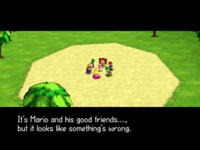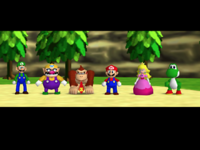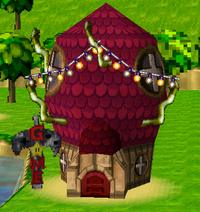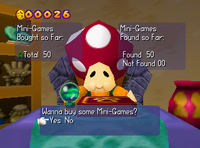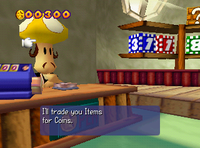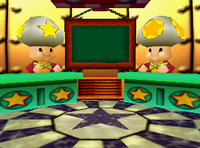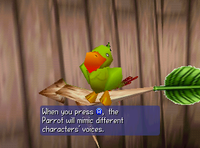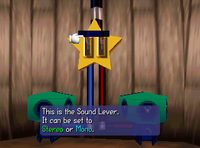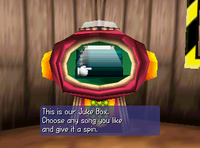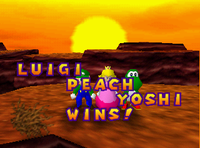Mario Party: Difference between revisions
Tag: Mobile edit |
m (→Differences from Japan: Found a compromise by using Google Translate. I know that's discouraged, but if you feel it's wrong, then undo this edit.) |
||
| Line 342: | Line 342: | ||
===Differences from Japan=== | ===Differences from Japan=== | ||
In the Japanese versions, Wario and Luigi say "Oh my God!" when they lose. This was changed in the Western versions to remove religious references; Luigi wails in pain instead, and Wario says "So ein Mist!", which people have mistaken for "D'oh I missed!"<ref>https://www.youtube.com/watch?v=2hcU8Yrqlqk</ref>, which is German for " | In the Japanese versions, Wario and Luigi say "Oh my God!" when they lose. This was changed in the Western versions to remove religious references; Luigi wails in pain instead, and Wario says "So ein Mist!", which people have mistaken for "D'oh I missed!"<ref>https://www.youtube.com/watch?v=2hcU8Yrqlqk</ref>, which is German for "Blast it!". | ||
{{media table | {{media table | ||
|type1=audio | |type1=audio | ||
Revision as of 14:58, May 21, 2017
- This article is about the first Mario Party game for the Nintendo 64. For the Mario Party series as a whole, see Mario Party (series).
Template:Infobox Mario Party (Japanese: マリオパーティ, Mario Pāti) is a video game based on a board game for the Nintendo 64, and the first game of the Mario Party series. Players choose one of six characters and move around the board. As they go around, they collect coins and various other items that can help them or hinder others in their quest to collect Stars.
What sets this game apart from others is the mini-games that follow each round. The players will be grouped together in groups of two, three against one, or everyone for themselves. They then compete in a game that tests their reflexes, puzzle solving skills, or plain luck. The winners will be awarded coins, and in certain mini-games, the losers can lose five coins each. Mini-games also exist that allow players to steal as many coins as they can from each other. Both of these features were removed in future installments for being too harsh.[citation needed]
Story
One day, Mario and his friends are sitting around arguing over who is the Super Star. Wario states that a Super Star must be strong, to which Donkey Kong agrees. Both get into an argument over who is stronger. Toad says that maybe Mario would make a good superstar, or Princess Peach, or even the energetic Yoshi. The gang starts to close in on Toad, who shouts out that he has an idea of what they should do. He suggests that the crew take the Warp Pipe in Mushroom Village, and find out who is the Super Star of their adventures. He warns that the road will be dangerous and that being the super star requires not only strength, but courage, wisdom and kindness. Luigi bravely agrees first to this plan and steps off to find the warp pipe. Wario follows and the group agrees to the plan and also set off to find the warp pipe and become the next Super Star.
Playable characters
Mario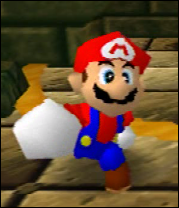
|
Luigi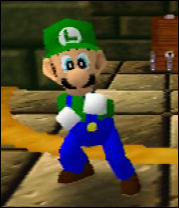
|
Princess Peach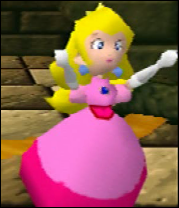
| |||
|---|---|---|---|---|---|
Yoshi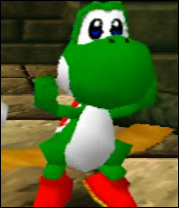
|
Wario
|
Donkey Kong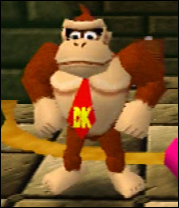
|
Game modes
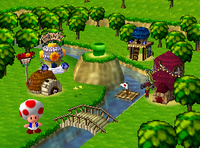
Game modes are selected from a "Map" screen, Mushroom Village, that the player is led to once starting the game. Each building or feature represents a mode, and the player can select one to play a certain mode.
Listed below are the available areas for the player to access in Mario Party:
Party mode
Party mode is the heart of Mario Party. Four players will play on a board game, each getting a turn to roll the 1-10 Dice Blocks, which will determine how many spaces they will move across. After everyone rolls, a roulette will appear which will randomly select a minigame to play. This process will repeat itself until the set amount of turns is up.
Boards
| Board | Description | Difficulty | |
|---|---|---|---|
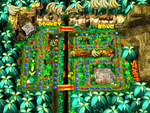
|
DK's Jungle Adventure | DK's Jungle Adventure is Donkey Kong's board. Players aim to collect Stars in order to locate the mysterious treasure that is locked away in the jungle's ancient ruins. Four Whomps are guarding the junctions; to pass, a player must pay 10 Coins. Landing on a Happening Space triggers a rolling boulder which in turn chases down any players standing in its way all the way to the path near the start of the board. If a player happens to meet Bowser on this board, they are "awarded" a useless Golden Bowser Statue and are forced to pay him 10 coins. | File:Star.PNG |

|
Peach's Birthday Cake | Peach's birthday cake is Princess Peach's board. It is the smallest map of the ones available in Mario Party. Its main feature is the Flower Lottery, where a player plants a red, blue, yellow, or green seed (at the cost of 10 coins) and grows a flower. Three flowers have a Toad face, while one flower has a Bowser face on it. After all four seeds are planted, four new ones can be chosen. This is run by a Goomba, who says if a player gets the Bowser face, he will "win" the lottery and go to Bowser, who will sell him the Bowser cake, one of Bowser's bogus items, for 20 coins. If one gets a Toad face one will "lose" the lottery and go in the direction of the Star. If a player lands on a Happening Space, they have the opportunity to plant a "Strawberry Seed" at the cost of 30 coins, which grows into a Piranha Plant. Once planted, if another player with stars lands on the Happening Space with the Piranha Plant there, it will steal a star from that player, and give it to the player that planted it. | File:Star.PNGFile:Star.PNG |

|
Yoshi's Tropical Island | Yoshi's Tropical Island is Yoshi's board. Consisting of Watermelon Island, Cantalope Island, and a small island in the middle, it was said that many Yoshis live here, but only two are shown in the middle of the board. A Pink Yoshi is on the small island and is surrounded by whirlpools, with a Blue Yoshi who can't do anything about it. Players aim to collect stars to get rid of the whirlpools and reunite the two Yoshis. The Happening Spaces make Bubba the fish take Toad to the opposite island, Bowser taking his place. Bowser sells defective Bowser Tubes to players for 30 coins. Two Thwomps block both ways to the opposite island, and request fees from players if they want to pass. The fee always starts at one coin, but goes up by one coin each time until it reaches the limit of 50 coins to pass. | File:Star.PNGFile:Star.PNG |
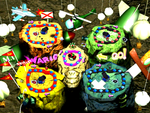
|
Wario's Battle Canyon | Wario's Battle Canyon is Wario's board. It is set on a canyon that has been split into four areas with Bowser's area in the middle. Players aim to collect stars to stop the feud between the Bob-omb Buddies and the Bob-ombs. To get around the board, players are placed into cannons and fired to another area; the area they are sent to is determined by a spinning wheel. If a player lands on a Happening Space, the Bob-ombs will switch the directions of the cannons. Bowser's area can only be reached by asking the Fly Guy in the northeast area to carry the character conversing with him to Bowser for ten coins. Bowser also has a cannon in this area to replace his bogus item. However, instead of firing at a specific part of the board, Bowser will just fire a character at a random spot. | File:Star.PNGFile:Star.PNG |
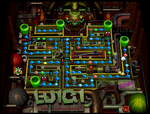
|
Luigi's Engine Room | Luigi's Engine Room is Luigi's board. Players need to collect stars to power up the engine in the middle of the room (but actually in the back of the playing board). The main feature is the board-wide system of red and blue doors. One set rises up to block specific paths while the other set goes down to open other paths. The doors switch at the start of every turn, when players land on certain Happening Spaces, or if a robot on the board is paid 20 coins to switch them. ? spaces on steam generators near the engine make steam rise up out of the respective generator, propelling players to a higher section. Players that go to Bowser will see his "Make As Many Coins As You Want Mecha" in action. They will get a coin from Bowser, at the cost of 20 coins. No matter where the players go, all paths end in Warp Pipes that lead to Boo, who is near the start. | File:Star.PNGFile:Star.PNGFile:Star.PNG |
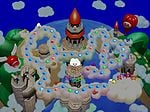
|
Mario's Rainbow Castle | Mario's Rainbow Castle is Mario's board. It is placed on clouds with multiple towers, and is sky-themed. The main feature of this board is that the location of the Star does not change each time a player receives one. Instead, it is always located on the main tower of the map. Each time a player does receive a Star, however, the tower rotates, revealing Bowser. When the player reaches the tower while Bowser is there, he charges 40 coins for a Ztar. Unlike their later appearances, they do not affect the star count, merely serving to waste the 40 coins. The tower can also be rotated by any player landing on a Happening Space. | File:Star.PNG |
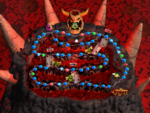
|
Bowser's Magma Mountain | Bought for 980 coins, after all other boards are played at least once (similar to Eternal Star). | File:Star.PNGFile:Star.PNGFile:Star.PNG |

|
Eternal Star | Unlockable after 100 stars are gathered and all other boards are played once. | File:Star.PNGFile:Star.PNGFile:Star.PNG |
Spaces
| Space | Description | |
|---|---|---|
| Blue Space | Players will gain three coins from landing on this. The amount of coins received will be doubled in the last five turns. This space is the most common space on all boards. | |
| Red Space | Anybody who lands on this space will lose three coins. On the last five turns, this amount will be doubled. | |
| Happening Space | A variety of events will happen if anyone happens to land on this space. These events can help or harm one or more players, and they differ from board to board. | |
| Chance Space | A player that lands here will play a Chance Time game. The player hits three blocks, which identify two players and what one will give to the other. Game-changing events can happen here, from trading stars or coins, to giving one star or 10-30 coins to someone else. | |
| Mini-Game Space | A player that lands here will play a One-Player Mini-Game. If the player wins the mini-game, they will receive coins. If they lose, then the player loses five coins. If the game is a bonus mini-game though, the player will be rewarded the amount of coins collected, but not lose any if they get none. | |
| Mushroom Space | A roulette block will appear if a player lands on this space. Either the player can receive a Mushroom, which will give the Player the chance to roll another dice block, or receive a Poison Mushroom, which will force them to forfeit their next turn's Dice Block roll. | |
| Bowser Space | Any player who lands on this space will trigger a roulette, which any of these events can follow:
|
There is also a Star Space. When a player passes here, they can obtain a Star only if they have at least 20 Coins. The Star Space won't count towards the player's movements, unlike other spaces.
Mushroom Village
Mini-Game House
The Mini-Game House is located to the right side of the river, and resembles a mushroom with a large, red cap.
Toad
The resident Toad of the Mini-Game house is an elderly-looking one named Puff who has a large red cap on its head, similarly shaped to the Mini-Game House itself. By speaking to her, the player is given a list of mini-games that have been played in the game so far. There are various price ranges of mini-games. Once one is bought, it can always be played for free via the orb on the table.
Pot o' Skills
The Pot o' Skills leads to the Mini-Game Stadium. The Mini-Game Stadium has its own board shaped in the form of a star, and only has 24 total spaces. Each turn, players roll the dice and advance the number of spaces, like in Party Mode. However, blue spaces do not add coins and red spaces do not subtract coins. All coins are gained or lost from mini-games which are played at the end of each turn. There is a One-Player mini-game space as well. Passing Koopa will result in 10 coins for the player. At the end of the game, the player with the most coins wins.
Mushroom Shop
The Mushroom Shop is run by the Mushroom Shop Clerk and is located on the left side of the river on the map, it resembles a brown mushroom on its side. In the shop, various items can be bought with Coins earned from mini-games and Party games. Here is a listing of every item, along with its price and in-game description.
| Image | Name | Price | In-Game Description | Notes |
|---|---|---|---|---|
 |
This appears randomly, and you get the number of coins shown. | |||
 |
This appears randomly, and you lose the number of coins shown. | |||
 |
This appears randomly, and only numbers eight to 10 will appear on the block. | |||
 |
This appears randomly, and only numbers one to three appear on the block. | |||
 |
This appears randomly, and players change positions on the board. | |||
 |
This appears randomly, and Boo, Koopa Troopa or Bowser will appear. | |||
 |
This counts how many times you rotate the Control Stick. Use it in the Mini-Game House. | |||
 |
This is the Record for the Juke Box in the Option House. | |||
 |
This Parrot is good at mimicking characters' voices. It lives in the Option House. | |||
 |
Get 10 percent interest on Coins you collect with this Lucky Box. | |||
 |
Bet your Coins with this Box to get double or half of what you actually collected. | |||
 |
||||
 |
This lets you see the End Credits and the names of people who made the game. | Complete the Eternal Star map to obtain this. | ||
| Koopa Troopa won't appear on the map, but it won't work on some maps. | Complete the Eternal Star map to obtain this. | |||
| Boo won't appear on the map, but it won't work on some maps. | Complete the Eternal Star map to obtain this. | |||
 |
This has many Gameballs with Mini-Games inside. What you get is a surprise. | This item appears after at least 30 mini-games have been bought from the Mini-Game House and can be used until all mini-games are bought. |
Mushroom Bank
The Mushroom Bank is where players can store their coins as well as Stars and items. The bank is run by two portly Toads who are similar in every way except that one has yellow stars on his head in place of the usual dots, while the other has orange stars within yellow circles.
The Left Toad
The Toad behind the left counter, whose name is Porto, is in charge of storing the items the player buys at the Mushroom Shop until they are used during a game. Here is also where the player can choose how they want to save their coins, whether with the Coin Box, Lucky Box, or Casino Box.
The Right Toad
The Toad behind the right counter, whose name is Bello, will tell the player how many total coins and stars the player has saved up. He will also say how many more stars need to be collected, out of 100, in order to unlock the Eternal Star map.
Option House
The Option House is a mushroom-resembling blue-topped toward the top of the map across the river. As the name suggests, it is used to adjust the multiple options for the game. There are other features such as the Talking Parrot and Juke Box as well.
Toad
The resident Toad of the Option House, whose name is Fun Gus, can delete all saved data. Once spoken to and asked to delete all data, he takes out a remote and opens an electrical box on the other side of the house. The cover will open revealing a large red switch, and the player is asked if they are sure about deleting their data. Once the player accepts deleting the data, he/she should either press ![]() to press the switch and erase all data, or press
to press the switch and erase all data, or press ![]() to cancel the process.
to cancel the process.
Talking Parrot
The Talking Parrot is an item that can be bought from the Mushroom Shop, and once bought, will appear on a perch in the Option House. By pressing the ![]() button, the parrot speaks various voices from various characters in the game. Two lines of dialogue were edited from the Japanese version to remove religious references, which were Luigi and Wario exclaiming "Oh my God!" after losing mini-games. These voices include:
button, the parrot speaks various voices from various characters in the game. Two lines of dialogue were edited from the Japanese version to remove religious references, which were Luigi and Wario exclaiming "Oh my God!" after losing mini-games. These voices include:
- Boo
- Bowser
- Donkey Kong
- Koopa Troopa
- Luigi
- Mario
- Princess Peach
- Toad
- Yoshi
- Wario
- The "narrator" voice that announces events in mini-games such as "Time Up!", "Game Over!", "Draw!", etc.
Sound Lever
The Sound Lever is a lever that changes the sound from Mono to Stereo or vice versa. There are two speakers at the bottom with pipes leading up the lever. By pulling the lever down, one of the speakers are deactivated and the sound is changed to Mono. There is no surround sound.
Juke Box
The Juke Box allows the player to listen to any song from the game. The only prerequisite is that the player must have heard the song in the game itself before it becomes available on the Juke Box. The Juke Box becomes available for use after the player buys the Record from the Mushroom Shop for 50 Coins. For PAL and Japanese players, an extra song is available entitled "Move to the Mambo!", which is unavailable in the American version. No official explanation has ever been released as to why it was removed.
Mini-Game Island
Mini-Game Island is a special challenge in which the goal is to travel all around the island and beat every mini-game one by one. After beating every mini-game and reaching the end, Toad will challenge the player once more to a race against him and two other CPUs in Slot Car Derby. This mode is for one player only. Completing the mode will reward the player with the Bumper Ball Maze minigame, which can be accessed in the Minigame House.
Mini-games
- Main article: List of Mario Party minigames
Staff
- Main article: List of Mario Party staff
Pre-release and unused content
- Main article: List of Mario Party pre-release and unused content
Gallery
- For this subject's image gallery, see Gallery:Mario Party.
Media
Reception
Mario Party received mostly positive reviews from critics. The most frequent criticism Mario Party received was the lack of enjoyment without multiplayer. GameSpot explains "The games that are enjoyable to play in multiplayer are nowhere near as good in single player mode. Really it's that multiplayer competitive spark of screaming at and/or cheering for your friends that injects life into those often-simple little games and without it, they're just simple little games." IGN took a similar line, saying that it was the interaction between players rather than the interaction between the game that made Mario Party fun. Another common criticism was the game's dependence on luck rather than skill, though it this was seen by many to add to the game's board game atmosphere, as players who were comfortably in the lead one turn could be losing the next.
Nintendo of America sent the gaming magazine Game Informer a sarcastic certificate over the publication's negative review of Mario Party and its sequel[1].
Mario Party is the 17th best selling game for the Nintendo 64, selling approximately 2.7 million copies: 1.23 million copies in North America, 870,000 copies in Japan, and 580,000 copies elsewhere [1].
Legal issues
Nintendo gave away a free Mario Party glove for a time after the game's release, the reason being that many players got blisters and other ailments on the palms of their hands due to the mini-games that involve spinning the ![]() around as fast as possible (this is also commonly thought to be the reason Mario Party wasn't released on the Virtual Console, but Mario Party 2 was). Nintendo suggested that the players should use the thumb to spin the Control Stick, but this method is a lot slower than rotating with the palm of the hand, and the thumb can slip off the joystick. Receiving the glove required proof of purchase of the first game of the series. The glove giveaway did not surface until after the release of Mario Party 2. This was because Nintendo lost a class action lawsuit that was filed by several families of the injured players and had to pay several thousands of dollars in damage reparations as a result. As a consequence of unbalanced difficulty and self-injury, there were no more mini-games after Mario Party that involved spinning the Stick as fast as possible until Mario Party: Island Tour was released since the analog stick on the 3DS made it safe to spin quickly without injuries.
around as fast as possible (this is also commonly thought to be the reason Mario Party wasn't released on the Virtual Console, but Mario Party 2 was). Nintendo suggested that the players should use the thumb to spin the Control Stick, but this method is a lot slower than rotating with the palm of the hand, and the thumb can slip off the joystick. Receiving the glove required proof of purchase of the first game of the series. The glove giveaway did not surface until after the release of Mario Party 2. This was because Nintendo lost a class action lawsuit that was filed by several families of the injured players and had to pay several thousands of dollars in damage reparations as a result. As a consequence of unbalanced difficulty and self-injury, there were no more mini-games after Mario Party that involved spinning the Stick as fast as possible until Mario Party: Island Tour was released since the analog stick on the 3DS made it safe to spin quickly without injuries.
Differences from Japan
In the Japanese versions, Wario and Luigi say "Oh my God!" when they lose. This was changed in the Western versions to remove religious references; Luigi wails in pain instead, and Wario says "So ein Mist!", which people have mistaken for "D'oh I missed!"[2], which is German for "Blast it!".
References to other games
- Super Mario Bros. 3: Some songs are cover versions of some world maps from the game. For example, "Let's Go Lightly" is based on World 4 Big Island, "Slowly, Slowly" is based on World 6 Iced Land, and "Dodging Danger" is based on World 8 Castle of Koopa, but with some additional rhythm.
- Super Mario 64: Peach's Birthday Cake is based on Princess Peach's letter that she baked a cake for Mario, and the layout of the board and background surrounding it are based from the photograph after the credits. Also, Mario's Rainbow Castle board is based on the secret course Tower of the Wing Cap, and the Wing Cap is used as a prop on his board map, and finally the board game's ending cutscene is based on another secret course Wing Mario Over the Rainbow. The ending cutscene for Luigi's Engine Room has the board reveal itself to take place inside a flying ship much like the Rainbow Cruiser from the course Rainbow Ride, though however with a completely different design. Bubba from Tiny-Huge Island makes an appearance on Yoshi's Tropical Island to capture Toad and send him to the other island where he and Bowser trade places if the player lands on a ? Space. Mario's title screen (if he wins the board game under the title of being a Superstar) depicts him with the Wing Cap flying with the other playable characters.
- Mario Kart 64: Some of Luigi, Peach, Wario and Toad's voice clips from the Japanese version were reused in this game. On the other hand, some of their phrases were re-recorded (eg. "Yeah! Peach's got it!").
Trivia
- This is the only Mario Party game to have a title screen that changes depending on which character wins a board, except for Mini-Game Stadium.
- If more than one character wins a mini-game, it will be shown with an error, with the singular "wins" being used instead of the plural "win" or the past tense "won". This was fixed in subsequent games.
References
- ^ Ryckert, Dan (September 18, 2000). Replay - Mario Party 3, Game Informer, Retrieved February 18 2015
- ^ https://www.youtube.com/watch?v=2hcU8Yrqlqk
Template:MP1 Template:Mariogames
| Nintendo 64 games | ||
|---|---|---|
| Super Mario franchise | Super Mario 64 (1996) • Mario Kart 64 (1996) • Mario no Photopi (1998) • Mario Party (1998) • Mario Golf (1999) • Mario Artist: Paint Studio* (1999) • Mario Party 2 (1999) • Mario Artist: Talent Studio* (2000) • Mario Artist: Communication Kit* (2000) • Mario Tennis (2000) • Paper Mario (2000) • Mario Artist: Polygon Studio* (2000) • Mario Party 3 (2000) • Dr. Mario 64 (2001) | |
| Donkey Kong franchise | Diddy Kong Racing (1997) • Donkey Kong 64 (1999) | |
| Yoshi franchise | Yoshi's Story (1997) | |
| Crossovers | Super Smash Bros. (1999) | |
